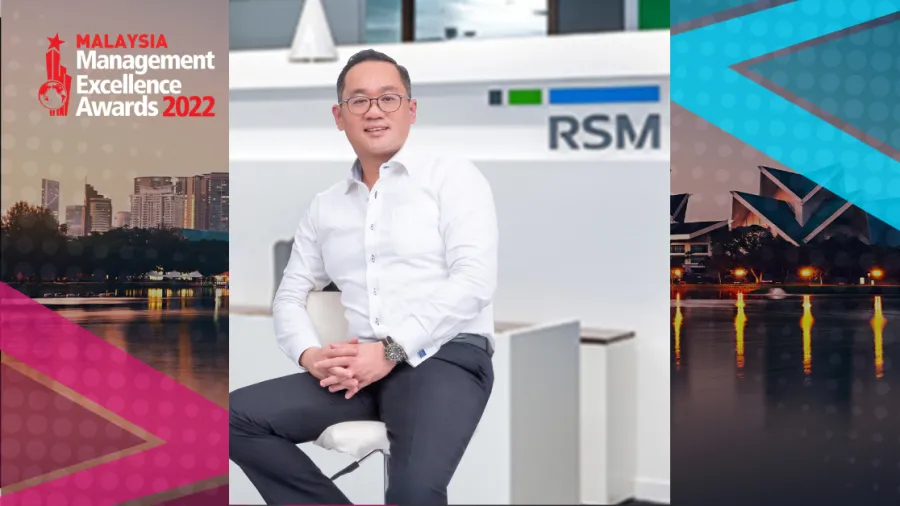
Businesses must create awareness to promote ESG, says RSM Malaysia partner
Organisations in Malaysia may be hesitant to embrace this trend amidst significant costs.
Hoe Yin is a Partner at RSM Malaysia, leading the firm’s Audit & Assurance and Transactions Advisory service lines. Apart from audits, he specialises in financial due diligence, review of post-closing completion accounts and post-acquisition support for integration and disputes. He also actively advises clients during the acquisition process and the pre-closing and post-closing stages, primarily in middle-market transactions.
Hoe Yin is also involved in the coordination and execution of cross-border transactions for both buy-side and sell-side clients. He also acts as an expert witness and works with lawyers on various litigation support assignments.
Prior to joining RSM Malaysia, Hoe Yin was attached to a Big Four accounting firm in Malaysia where he had obtained wide exposure in the profession.
Speaking about the Malaysian business landscape, Hoe Yin pointed out that although the momentum to adopt ESG and sustainability has picked up significantly in the past few years, not all stakeholders are on board. He mentioned that adoption is still very much driven by regulators and financial institutions in Malaysia.
“Challenges are also expected to come from expectation gaps where, on the one hand, arguments point to how ESG practices add value to businesses, but on the other hand, they narrow the options of how businesses make money,” he said.
The partner at RSM Malaysia spoke with Malaysia Management Excellence Awards to discuss how businesses in Malaysia can stay on top amidst a challenging environment and measure growth and success, as well as the impacts of ESG programmes and diversity and inclusion in a company’s operations.
How do you think Malaysian businesses can stay on top amidst a challenging global economic situation?
The current global economic outlook continues to be clouded by rising inflation and recession fears. Against this backdrop, I believe that businesses should embrace collaboration with each other, such as partnership, M&A, amongst others, and come together to improve the effectiveness and efficiencies of their value chain, offer highly competitive products or services in order to gain access to new markets.
Business owners need to know the strengths and weaknesses of their business, products, and services, and be alert to opportunities and threats arising from the ever-changing macro-environment. Business owners should strive to ensure optimum operational effectiveness and, at the same time, ensure that the products and services they offer create value for end consumers/customers.
Whilst I agree that it is important to control and minimise costs and expenditure, nonetheless research and development is important to create new sources of revenue or to keep the existing products or services relevant and competitive. For this, I am reiterating a phrase I quoted last year, the 2,000 year old Chinese saying of “开源节流” - we should broaden our sources of income first whilst looking for ways to control our costs and expenses, and not the other way around.
As mentioned earlier, global economic conditions are not great and business owners need to pay attention to the cash flow of their business and credit risk management to minimise risk of a liquidity crunch. Apart from cash flow management, businesses should explore and understand the options available to them in raising funds, particularly in times of high interest rates.
Digitalisation and the adoption of new technologies by businesses have been the most spoken-of strategies during the pandemic and post-pandemic recovery. I believe it will remain relevant in challenging times like these, and I expect this to be the way forward if businesses would like to stay on top of their game.
What are your key performance indicators in measuring businesses’ growth and success? How can management make these indicators more effective?
I do not think there is a one size fits all key performance indicators (KPIs); they vary between companies and industries.
The goal of KPIs is to communicate results succinctly. It is therefore important for management to understand the objective and strategic direction of the organisation before adopting a set of KPIs. Otherwise, it is merely an administrative task, a form-filling exercise that does not bring about effective performance measurement.
In order to make KPIs more effective, management may consider the following:
Be clear of the strategic direction and goals of the organisation. KPIs should be set pragmatically, in measuring metrics which will assist the management to achieve the organisation’s strategic direction and goals. Good KPIs provide objective and clear information on progress towards an end goal. The ultimate goal of KPIs is to help management make more informed decisions.
KPIs should be set with the organisation as a whole in mind, with the organisation’s ultimate goals at the forefront, as it is by human nature that the focus may be diverted from the broader strategy to only achieving the KPIs.
Be “SMART.” KPIs should be specific, measurable, attainable, realistic, and time-bound.
Adaptability. In times of heightened uncertainties, management should review and revise their KPIs more frequently so as to keep them relevant in driving the organisation towards its goals.
Straight to the point. Having too many KPIs, or unclear KPIs, will be confusing and difficult to comprehend. KPIs should be short and concise.
Effective data collection. In order to achieve a performance measurement through analysis of KPIs, the management must ensure the integrity, reliability and objectivity of the data collection process.
As industries are urged to employ ESG and sustainability programmes in their operations, what do you think management can do to promote this amongst its stakeholders? What do you think will be some of the challenges in this undertaking?
Although the momentum to adopt ESG and sustainability has picked up significantly in the past few years, not all stakeholders are onboard; particularly in Malaysia, adoption is still very much driven by regulators and financial institutions. Business owners in Malaysia may be hesitant to embrace ESG where the cost could be significant and returns are uncertain.
To promote ESG amongst its stakeholders, businesses need to create awareness through educating stakeholders on the value it creates, such as how it can be an impetus for future growth and help bolster the companies’ branding and credibility. Business owners need to highlight the consequences of not employing any ESG programmes as well, which includes loss of key customers, markets or investors. We have recently seen Malaysian companies facing adverse consequences such as having their exported goods withheld in foreign borders due to alleged governance failure and alleged mistreatment of workers.
Often, business owners in the middle markets will take a wait-and-see approach, and only implement such initiatives when it is a regulatory requirement. Until it is proven that the adoption of ESG and sustainability programmes bring about tangible advantages and benefits, which from a commercial viewpoint is often measured monetarily, it will remain challenging to convince business owners in the middle markets to embark on this voluntarily. Challenges are also expected to come from expectation gaps, where, on one hand, arguments point to how ESG practices add value to businesses, but on the other hand, they narrow the options of how businesses make money.
How can management ensure an inclusive and empowering environment for their employees?
I think the key to having an inclusive and empowering environment would depend very much on the “tone from the top” driving a culture of inclusivity and empowerment within the organisation. Leaders must first buy into the importance of diversity and inclusion and believe that an inclusive working environment stands ready to transform, grow, and outpace their competitors.
Leadership of organisations have to recognise that diversity is far broader than race and gender. It is the “difference” in the diversity that many have been neglected because of the perception that diversity and inclusion are merely making sure that everyone is represented and integrated into an organisation. There is a rising need to build on the traditional foundations of diversity and inclusion for organisations to reap the benefit from the “difference” that every individual brings, harnessing “difference” by leveraging the advantage that comes with it. The concept is no longer merely about bringing a diversified pool of people together, but more about creating an ecosystem where “difference” is not simply a problem to be solved but a competitive asset to be leveraged.
Leadership of organisations can shape their approach to diversity and inclusion by walking the talk and being empathetic to create a culture that embraces diversity and inclusion, say by ensuring diversity is represented in the senior leadership and beyond; as well as taking sustained and collaborative approach to ensure that the above is a continued effort.
A litmus test of a successful diversity and inclusion programme is when employees are comfortable enough to be themselves and not feel that their differences will affect their career progression within the organisation.
As a judge in this year’s Malaysia Management Excellence Awards, what are you hoping to see from this year’s entries? What qualities stand out for you?
Efforts and initiatives, including ESG and sustainability practices, that had made a positive impact on the organisation and its stakeholders would be qualities that would stand out for me as a judge for this year’s Malaysia Management Excellence Awards.
I would view the pandemic and current economic conditions as tests to the organisation and its management, on how the organisation remained sustainable, to continue to provide the best products or services to their customers or clients without compromising on the wellbeing of its employees and at the same time, still be able to contribute towards the community as part of its CSR efforts.
I will also consider how the candidates have embarked on the journey of ESG and sustainability practices adoption, and I will pay particular attention to whether the candidates have gotten themselves confused that ESG is just all about CSR.



![SBR 5 Lorem Ipsum News 2 [8 May]](https://cmg-qa.s3.ap-southeast-1.amazonaws.com/s3fs-public/styles/exclusive_featured_article/public/2025-05/a_hand_pointing_to_a_futuristic_technology_5b87c9d0e3_3.png.webp?itok=M3Hf-9XR)
![SBR 4 Lorem Ipsum [8 May Top Stories]](https://cmg-qa.s3.ap-southeast-1.amazonaws.com/s3fs-public/styles/exclusive_featured_article/public/2025-05/a_hand_pointing_to_a_futuristic_technology_5b87c9d0e3_2.png.webp?itok=2m5Wl0MX)


![Exclusive three SBR 12 Lorem Ipsum [8 May]](https://cmg-qa.s3.ap-southeast-1.amazonaws.com/s3fs-public/styles/exclusive_featured_article/public/2025-05/a_hand_pointing_to_a_futuristic_technology_5b87c9d0e3_11.png.webp?itok=8kn_UIfA)
![SBR 3 Lorem Ipsum [ Exclusive 2]](https://cmg-qa.s3.ap-southeast-1.amazonaws.com/s3fs-public/styles/exclusive_featured_article/public/2025-05/a_hand_pointing_to_a_futuristic_technology_5b87c9d0e3_1.png.webp?itok=YCyjLegJ)
![SBR 2 Lorem Ipsum [8 May]](https://cmg-qa.s3.ap-southeast-1.amazonaws.com/s3fs-public/styles/exclusive_featured_article/public/2025-05/a_hand_pointing_to_a_futuristic_technology_5b87c9d0e3_0.png.webp?itok=_cKD-29o)

![Video [Event News]](https://cmg-qa.s3.ap-southeast-1.amazonaws.com/s3fs-public/styles/event_news_featured_article/public/2025-05/screenshot-2025-05-08-at-4.58.53-pm_0.png.webp?itok=Kud35sMs)
![Event News SBR 9 Lorem Ipsum [8 may]](https://cmg-qa.s3.ap-southeast-1.amazonaws.com/s3fs-public/styles/event_news_thumbnail/public/2025-05/a_hand_pointing_to_a_futuristic_technology_5b87c9d0e3_8.png.webp?itok=DTh_dbYp)
![Event News SBR 9 Lorem Ipsum [8 May]](https://cmg-qa.s3.ap-southeast-1.amazonaws.com/s3fs-public/styles/event_news_thumbnail/public/2025-05/a_hand_pointing_to_a_futuristic_technology_5b87c9d0e3_7.png.webp?itok=vzDAzb6V)
![Event News SBR 8 Lorem Ipsum [8 May]](https://cmg-qa.s3.ap-southeast-1.amazonaws.com/s3fs-public/styles/event_news_thumbnail/public/2025-05/a_hand_pointing_to_a_futuristic_technology_5b87c9d0e3_6.png.webp?itok=jvHFc4P6)
![Video [Event News]](https://cmg-qa.s3.ap-southeast-1.amazonaws.com/s3fs-public/styles/video_thumbnail/public/2025-05/screenshot-2025-05-08-at-4.58.53-pm_0.png.webp?itok=yZnI0YBb)
![Video 1 SBR [8 May]](https://cmg-qa.s3.ap-southeast-1.amazonaws.com/s3fs-public/styles/video_thumbnail/public/2025-05/screenshot-2025-05-08-at-4.58.53-pm.png.webp?itok=9AAeRz_k)

 Advertise
Advertise

